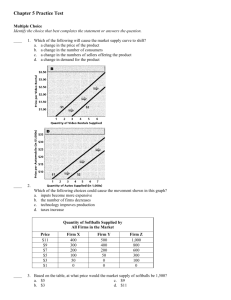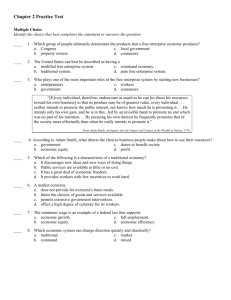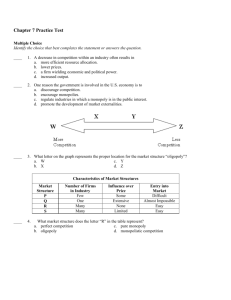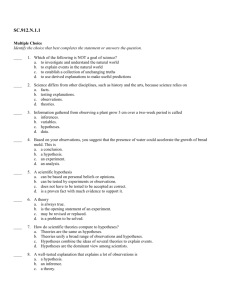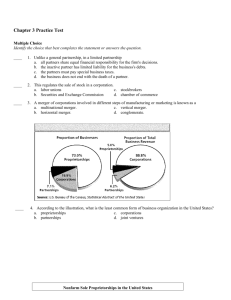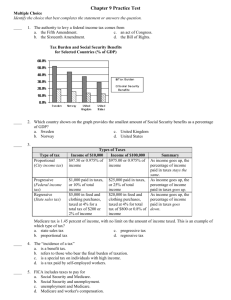Practice 2nd Exam De..
advertisement
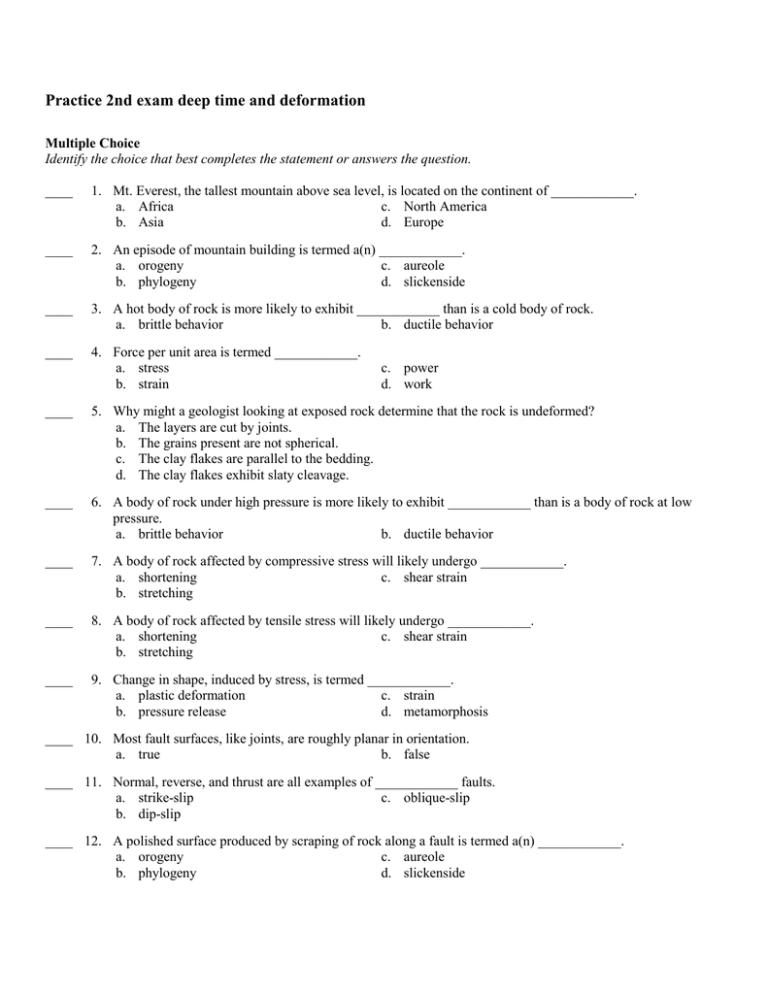
Practice 2nd exam deep time and deformation Multiple Choice Identify the choice that best completes the statement or answers the question. ____ 1. Mt. Everest, the tallest mountain above sea level, is located on the continent of ____________. a. Africa c. North America b. Asia d. Europe ____ 2. An episode of mountain building is termed a(n) ____________. a. orogeny c. aureole b. phylogeny d. slickenside ____ 3. A hot body of rock is more likely to exhibit ____________ than is a cold body of rock. a. brittle behavior b. ductile behavior ____ 4. Force per unit area is termed ____________. a. stress b. strain c. power d. work ____ 5. Why might a geologist looking at exposed rock determine that the rock is undeformed? a. The layers are cut by joints. b. The grains present are not spherical. c. The clay flakes are parallel to the bedding. d. The clay flakes exhibit slaty cleavage. ____ 6. A body of rock under high pressure is more likely to exhibit ____________ than is a body of rock at low pressure. a. brittle behavior b. ductile behavior ____ 7. A body of rock affected by compressive stress will likely undergo ____________. a. shortening c. shear strain b. stretching ____ 8. A body of rock affected by tensile stress will likely undergo ____________. a. shortening c. shear strain b. stretching ____ 9. Change in shape, induced by stress, is termed ____________. a. plastic deformation c. strain b. pressure release d. metamorphosis ____ 10. Most fault surfaces, like joints, are roughly planar in orientation. a. true b. false ____ 11. Normal, reverse, and thrust are all examples of ____________ faults. a. strike-slip c. oblique-slip b. dip-slip ____ 12. A polished surface produced by scraping of rock along a fault is termed a(n) ____________. a. orogeny c. aureole b. phylogeny d. slickenside ____ 13. A joint always occurs as a single, isolated plane within a rock. a. true b. false ____ 14. It is possible for offset along an oblique-slip fault to have both ____________ and ____________ components. a. normal; reverse c. normal; left-lateral b. right-lateral; left-lateral ____ 15. In a ____________ fault, the fault plane is nonvertical, and the hanging-wall block moves downward relative to the footwall block. a. detachment b. normal c. reverse d. thrust ____ 16. Motion along all faults is either strike slip or dip slip; combinations of these two types of displacement are never found together in a single fault. a. true b. false ____ 17. In a ____________ fault, the fault plane is greater than 35° from horizontal and the hanging-wall block moves upward relative to the footwall block. a. detachment b. normal c. reverse d. thrust ____ 18. In a ____________ fault, the fault plane is less than 35° from horizontal and the hanging-wall block moves upward relative to the footwall block. a. detachment b. normal c. reverse d. thrust ____ 19. Shear stress at sufficient depth within a fault plane can induce ductile shear, forming a fine-grained metamorphic rock named ____________. a. ignimbrite c. mylonite b. gneiss d. migmatite ____ 20. Within a platform, sedimentary rocks always have a horizontal orientation. a. true b. false ____ 21. A geologist’s compass differs from the more widely known orienteering compass in that the geologist’s compass ____________. a. b. c. d. possesses an inclinometer, allowing the user to measure dip and plunge angles contains a barometer that warns the geologist of approaching storms can chemically analyze rock samples in the field needle points directly toward geographic north rather than geomagnetic north ____ 22. If a geologist was examining a line that ran across a rock face, how could he or she best determine whether the line was a joint or fault? a. by consulting a geologic map of the area b. by looking for telltale signs of movement on either side of the line c. by measuring the strike and dip of the line d. by looking for signs of erosion ____ 23. In the map below, the vertical, north-south trending fault is a ____________ fault. a. normal dip-slip b. reverse dip-slip c. right-lateral strike-slip d. left-lateral strike-slip ____ 24. A fold shaped like an elongate arch is a(n) ____________. a. anticline b. basin c. dome d. syncline ____ 25. The central portion of high curvature on a fold is termed the fold ____________. a. limb c. midsection b. hinge d. thorax ____ 26. A fold shaped like an right-side-up bowl is a(n) ____________. a. anticline b. basin c. dome d. syncline ____ 27. A fold shaped like an upside-down bowl is a(n) ____________. a. anticline b. basin c. dome d. syncline ____ 28. A fold shaped like an elongate trough is a(n) ____________. a. anticline b. basin c. dome d. syncline ____ 29. Tectonic foliation, such as elongation of quartz grains, always occurs parallel to the original bedding plane of a body of rock. a. true b. false ____ 30. The sides of a fold, where curvature is at a minimum, are termed ____________. a. branches b. limbs c. axial planes d. hinges ____ 31. On a geologic map, if the contacts between sedimentary rock units form a bull’s-eye pattern of concentric circles, with the youngest unit in the center, the underlying structure is a(n) ____________. a. anticline b. basin c. dome d. syncline ____ 32. On a geologic map, if the contacts between sedimentary rock units form a bull’s-eye pattern of concentric circles, with the oldest unit in the center, the underlying structure is a(n) ____________. a. anticline b. basin c. dome d. syncline ____ 33. On a geologic map, if the contacts between sedimentary rock units form a series of parallel lines, with the youngest unit in the center, the underlying structure is a(n) ____________. a. anticline b. basin c. dome d. syncline ____ 34. Mountain ranges are important sites for the formation of igneous and metamorphic rocks, but do not have any apparent relationship with the formation of sedimentary rocks. a. true b. false ____ 35. Orogenesis (mountain building) leads to the production of ____________. a. metamorphic rocks only c. sedimentary rocks only b. igneous rocks only d. any of the three rock types listed above ____ 36. Regions of continents that have not been subjected to orogeny during the past one billion years are termed ____________. a. exotic terranes c. cratons b. accreted terranes ____ 37. Why do mountains occur in distinctive belts? a. Rifts are linear features. b. Plates move linearly over hot spots. c. The processes that create mountains are linear. d. Both a and c are correct. e. Both b and c are correct. ____ 38. Mountain ranges are associated with modern and ancient convergent-plate boundaries, but do not form in association with either divergent- or transform-plate boundaries. a. true b. false ____ 39. Nearly all of the present mountain ranges are the products of single orogenic events. a. true b. false ____ 40. Why are Mt. Everest and the surrounding Himalayan Mountains still growing? a. They experience no erosion. b. The Indian Plate is still moving. c. India is made of stronger lithosphere than Asia. d. Both a and c are correct. e. Both b and c are correct. ____ 41. Theoretically, there is no reason why mountains substantially taller than Mt. Everest might not one day arise on Earth. a. true b. false ____ 42. The balance between the weight of a mountain range and the buoyancy provided by the underlying mantle is termed ____________. a. punctuated equilibrium c. isostatic equilibrium b. homeostatic equilibrium d. osmotic equilibrium ____ 43. Why are blocks of wood floating in water a good analogy for mountains floating on the asthenosphere? a. The materials on which they float have the same properties. b. A larger block of wood has more “showing” above the water. c. The mass of the displaced water is equal to the mass of the block below water. d. The blocks have positive buoyancy. ____ 44. Continental crust is typically 35 km thick, but may be up to ____________ thicker under mountain ranges. a. 20% c. 100% b. 50% d. 200% ____ 45. In order to maintain isostasy, what must occur after new igneous rock is added to the crust (either on top of or intruded into)? a. The asthenosphere must sink. b. The base of the lithosphere must sink in equal proportional to how much the surface has risen. c. The base of the lithosphere must sink but not as much as the surface has risen. d. The surface must rise in equal proportion to how much the asthenosphere has sunk. ____ 46. Regions where Precambrian metamorphic rocks are exposed at the surface are termed ____________. a. shields c. convergent margins b. platforms ____ 47. Valleys and hillsides carved by glaciers are generally more ____________ in comparison to those produced by rivers and streams. a. steep sided b. shallow sided ____ 48. If the relative age of two formations (with respect to one another) is known, then the numerical ages for each formation can be inferred. a. true b. false ____ 49. In the 1800s Lord Kelvin estimated the age of the Earth, utilizing a number of assumptions. Which wrong assumption was the primary reason why his estimate (approximately 20 million years) was so wildly inaccurate? a. that the Earth was once hotter than it presently is today b. that the Earth may have been molten when first formed c. that no new heat has been added to the Earth since its initial formation d. that the Earth would lose heat over time through radiation into outer space ____ 50. Why did James Hutton deduce that there must have been a long time before human history began? a. He found no physical remains of humans in his geologic investigations. b. No human had seen the full process of sediment deposition to mountain formation. c. He found no signs of humans in the ancient rock record. d. No human had observed continents in different locations. ____ 51. In an undisturbed sequence of sedimentary rocks, younger layers overlay older layers, according to the principle of ____________. a. superposition b. original continuity c. original horizontality d. uniformitarianism ____ 52. As understood by modern geologists, the principle of uniformitarianism implies that ____________. a. Earth has always had the same basic appearance that it has today, with the distributions of ocean basins and continents identical to what we see today b. igneous, metamorphic, and sedimentary rocks are uniformly mixed throughout the crust of Earth c. physical processes observed today (such as erosion and volcanic eruption) have been active in the past and are responsible for the geologic history we see preserved in the rock record d. physical processes observed today (such as erosion and volcanic eruption) have been occurring throughout Earth history at constant rates; for example, no eruption in geologic time would have been greater than the 1815 Tambora eruption ____ 53. James Hutton, the “father of geology,” put forth the principle of ____________. a. superposition c. original horizontality b. original continuity d. uniformitarianism ____ 54. Which of the following geologic principles is a direct result of gravity? a. baked contacts b. cross-cutting relationships c. original horizontality d. inclusions ____ 55. Period names on the geologic time scale, such as Devonian and Permian, provide examples of ____________. a. relative age b. numerical age ____ 56. Within the world’s undisturbed sequences of sedimentary rocks, fossils ____________. a. are rarely, if ever, found b. are randomly distributed c. occur in an ordered sequence ____ 57. If the lithology and fossil content of two bodies of rock on opposite sides of a canyon are identical, then these remaining outcrops were likely physically connected at one time and formed part of an extensive, sheet-like layer of rock. This idea summarizes the principle of ____________. a. superposition b. original continuity c. original horizontality d. uniformitarianism ____ 58. The marble rind surrounding the granite pluton must be younger than the limestone according to the principle of ____________. a. superposition b. baked contacts c. original horizontality d. original continuity ____ 59. Which method of correlation is more reliable for determining age equivalence among bodies of rock that are physically isolated by vast distances? a. lithologic correlation b. fossil correlation ____ 60. Buried erosional surfaces between parallel sedimentary strata are termed ____________. a. disconformities b. angular unconformities c. nonconformities ____ 61. The surface below sedimentary rocks that overlie igneous or metamorphic rocks is termed a(n) ____________. a. disconformity b. angular unconformity c. nonconformity ____ 62. If horizontal sedimentary strata overlie tilted strata (and no fault is present), the surface between the horizontal and tilted strata must be a(n) ____________. a. conformable sedimentary contact b. angular unconformity c. disconformity d. nonconformity ____ 63. Which of the following is the most correct reason why no single location on Earth contains a complete record of Earth history? a. because of unconformities b. because of erosion c. because of times of nondeposition d. because deposition is constantly occurring ____ 64. The age of Earth CANNOT be reliably estimated from sediment thicknesses because ____________. a. sedimentation rates are not likely to remain constant at any one locality over all of Earth’s history b. sedimentary rocks can be metamorphosed or melted c. locally, much of Earth’s history is represented by unconformities between strata rather than the strata themselves d. All of the above are correct. ____ 65. Why do some rock formations go by names containing specific rock types, while others retain the word “formation”? a. It depends on the locality of the rock formation. b. Areas named as a “formation” contain more than one rock type. c. The rock type could not be determined if it was named “formation.” d. It is the choice of the person who first studies the rock formation. ____ 66. Which of the following is always the same for multiple isotopes of a single element? a. atomic number c. tendency to decay radioactively b. atomic mass number d. None of the above are correct. ____ 67. Two atoms of a single element that differ in number of neutrons are said to represent two distinct ____________ of that element. a. isomers c. isotherms b. isotopes d. atomic species ____ 68. When an unstable isotope decays, the daughter isotope that results is always a stable isotope. a. true b. false ____ 69. Dendrochonology involves dating of historic and geologic events through the study of ____________. a. growth layers in shells c. remnant magnetism in iron-rich minerals b. oxygen isotope profiles in glacial ice d. annual growth rings in trees ____ 70. Why were geologists able to switch from determining relative age of geologic events to determining the numerical age? a. New fossils were discovered. b. Radioactivity was discovered. c. New geologic units were discovered. d. Numerical age dating became more widely accepted. ____ 71. In an unweathered sample of detrital sedimentary rock, the ratio of an unstable isotope to its stable daughter isotope is 1/15. If no daughters were present at the time the grains formed, and the half-life of the reaction is 50 million years, how old is the rock? a. 200 million years c. 750 million years b. 400 million years d. None of the above are correct. ____ 72. If all of Earth history were compressed into a single year, Homo sapiens would first appear on ____________. a. February 26 (close to Mardi Gras) b. April 15 (just before taxes are due) c. October 31 (just in time for Halloween) d. December 31, at 11:59 P.M. (just before the ball drops on New Year’s Eve) ____ 73. Which statement best summarizes the development of the geologic time scale? a. Numerical ages for rocks were known well before the relative sequence of sedimentary layers was established. b. Relative ages for sedimentary strata were known well before accurate numerical dates for these rocks could be provided. c. Names of relative ages (such as Silurian) and accurate numerical dates for these ages appeared at about the same time. ____ 74. When radioactively dating a rock, which of the following would NOT result in an inaccurate age reading? a. using weathered rocks c. using all of the minerals present b. homogenizing the rock material d. using only the daughter isotopes ____ 75. Attempts to measure the age of Earth by extrapolating modern riverine influx rates into the past to produce modern marine salinity from an initially freshwater ocean failed to take into account that ____________. a. salt is removed through precipitation, balancing riverine input b. dissolved salts from weathering of rock only rarely are transported all the way to the ocean c. salts derived from the weathering of rock are insoluble in water ____ 76. Numerical ages for boundaries between time units on the geologic time scale primarily resulted from the study of ____________, in conjunction with relative age data. a. fossil content and spatial relationships among igneous rocks b. fossil content and spatial relationships among sedimentary rocks c. radiometric dating of igneous rocks d. radiometric dating of sedimentary rocks ____ 77. If a geologist wished to date an outcrop of sandstone beds that he or she found, which of the following should they look for to yield a specific date? a. a fossil known to have a wide geographic distribution and to have existed over a long range of time b. a sedimentary layer constrained by igneous or metamorphic rocks c. a fossil known to have a small geographic distribution and to have existed over a short range of time d. a sedimentary layer cut across by a fault ____ 78. Why can’t geologists isotopically date a clastic sedimentary rock? a. They do not contain the appropriate minerals. b. These types of rocks do not contain enough of the appropriate minerals to date. c. The minerals would yield the date of when they crystallized in a metamorphic or igneous rock. d. The minerals would yield the date of when they weathered from their source material. Practice 2nd exam deep time and deformation Answer Section MULTIPLE CHOICE 1. ANS: TOP: 2. ANS: TOP: 3. ANS: TOP: 4. ANS: TOP: 5. ANS: TOP: 6. ANS: TOP: 7. ANS: TOP: 8. ANS: TOP: 9. ANS: TOP: 10. ANS: TOP: 11. ANS: TOP: 12. ANS: TOP: 13. ANS: TOP: 14. ANS: TOP: 15. ANS: TOP: 16. ANS: TOP: 17. ANS: TOP: 18. ANS: TOP: 19. ANS: TOP: 20. ANS: TOP: 21. ANS: TOP: 22. ANS: B I A I B II.B A II.C C II.A B II.B A II.C B II.C C II.A A III.A B III.C D III.D B III.A C III.C B III.C B III.C C III.C D III.C C III.D B III.D A III.A B PTS: MSC: PTS: MSC: PTS: MSC: PTS: MSC: PTS: MSC: PTS: MSC: PTS: MSC: PTS: MSC: PTS: MSC: PTS: MSC: PTS: MSC: PTS: MSC: PTS: MSC: PTS: MSC: PTS: MSC: PTS: MSC: PTS: MSC: PTS: MSC: PTS: MSC: PTS: MSC: PTS: MSC: PTS: 1 Factual 1 Factual 1 Applied 1 Factual 1 Conceptual 1 Applied 1 Applied 1 Applied 1 Factual 1 Applied 1 Factual 1 Factual 1 Conceptual 1 Applied 1 Conceptual 1 Conceptual 1 Conceptual 1 Conceptual 1 Factual 1 Applied 1 Applied 1 DIF: Easy REF: 9.1 DIF: Medium REF: 9.1 DIF: Easy REF: 9.2 DIF: Easy REF: 9.2 DIF: Medium REF: 9.2 DIF: Medium REF: 9.2 DIF: Medium REF: 9.2 DIF: Medium REF: 9.2 DIF: Difficult REF: 9.2 DIF: Easy REF: 9.3 DIF: Easy REF: 9.3 DIF: Easy REF: 9.3 DIF: Medium REF: 9.3 DIF: Medium REF: 9.3 DIF: Medium REF: 9.3 DIF: Medium REF: 9.3 DIF: Medium REF: 9.3 DIF: Medium REF: 9.3 DIF: Medium REF: 9.3 DIF: Medium REF: 9.3 DIF: Difficult REF: 9.3 DIF: Difficult REF: 9.3 TOP: 23. ANS: TOP: 24. ANS: TOP: 25. ANS: TOP: 26. ANS: TOP: 27. ANS: TOP: 28. ANS: TOP: 29. ANS: TOP: 30. ANS: TOP: 31. ANS: TOP: 32. ANS: TOP: 33. ANS: TOP: 34. ANS: TOP: 35. ANS: TOP: 36. ANS: TOP: 37. ANS: TOP: 38. ANS: TOP: 39. ANS: TOP: 40. ANS: TOP: 41. ANS: TOP: 42. ANS: TOP: 43. ANS: TOP: 44. ANS: TOP: 45. ANS: TOP: 46. ANS: TOP: III.A D III.C A IV.A B IV.A B IV.A C IV.A D IV.A B IV.C B IV.A B IV.A C IV.A D IV.A B V.D D V.D C V D V B V.C B V.B | V.C E V.B B V C VI.A B VI.A C VI.A.i C V.A A VII MSC: PTS: MSC: PTS: MSC: PTS: MSC: PTS: MSC: PTS: MSC: PTS: MSC: PTS: MSC: PTS: MSC: PTS: MSC: PTS: MSC: PTS: MSC: PTS: MSC: PTS: MSC: PTS: MSC: PTS: MSC: PTS: MSC: PTS: MSC: PTS: MSC: PTS: MSC: PTS: MSC: PTS: MSC: PTS: MSC: PTS: MSC: PTS: MSC: Conceptual 1 Applied 1 Factual 1 Factual 1 Factual 1 Factual 1 Factual 1 Factual 1 Factual 1 Conceptual 1 Conceptual 1 Conceptual 1 Applied 1 Applied 1 Applied 1 Conceptual 1 Conceptual 1 Conceptual 1 Conceptual 1 Conceptual 1 Factual 1 Conceptual 1 Factual 1 Conceptual 1 Factual DIF: Difficult REF: 9.3 DIF: Easy REF: 9.4 DIF: Easy REF: 9.4 DIF: Easy REF: 9.4 DIF: Easy REF: 9.4 DIF: Easy REF: 9.4 DIF: Easy REF: 9.4 DIF: Medium REF: 9.4 DIF: Medium REF: 9.4 DIF: Medium REF: 9.4 DIF: Medium REF: 9.4 DIF: Medium REF: 9.4 DIF: Medium REF: 9.4 DIF: Medium REF: 9.5 DIF: Medium REF: 9.5 DIF: Medium REF: 9.5 DIF: Medium REF: 9.5 DIF: Difficult REF: 9.5 DIF: Medium REF: 9.6 DIF: Medium REF: 9.6 DIF: Medium REF: 9.6 DIF: Medium REF: 9.6 DIF: Difficult REF: 9.6 DIF: Easy REF: 9.7 47. ANS: TOP: 48. ANS: TOP: 49. ANS: TOP: 50. ANS: TOP: 51. ANS: TOP: 52. ANS: TOP: 53. ANS: TOP: 54. ANS: TOP: 55. ANS: TOP: 56. ANS: TOP: 57. ANS: TOP: 58. ANS: TOP: 59. ANS: TOP: 60. ANS: TOP: 61. ANS: TOP: 62. ANS: TOP: 63. ANS: TOP: 64. ANS: TOP: 65. ANS: TOP: 66. ANS: TOP: 67. ANS: TOP: 68. ANS: TOP: 69. ANS: TOP: 70. ANS: TOP: A VII B II.B C II.A B II.A A III C III D III C III A III.A C III.A B III B III B III.A A IV C IV B IV A IV D V B V A VII.A B VII.A B VII.A D VII.D B VII PTS: MSC: PTS: MSC: PTS: MSC: PTS: MSC: PTS: MSC: PTS: MSC: PTS: MSC: PTS: MSC: PTS: MSC: PTS: MSC: PTS: MSC: PTS: MSC: PTS: MSC: PTS: MSC: PTS: MSC: PTS: MSC: PTS: MSC: PTS: MSC: PTS: MSC: PTS: MSC: PTS: MSC: PTS: MSC: PTS: MSC: PTS: MSC: 1 Applied 1 Conceptual 1 Applied 1 Conceptual 1 Factual 1 Factual 1 Factual 1 Conceptual 1 Factual 1 Applied 1 Conceptual 1 Conceptual 1 Applied 1 Factual 1 Factual 1 Applied 1 Conceptual 1 Applied 1 Conceptual 1 Factual 1 Factual 1 Factual 1 Factual 1 Conceptual DIF: Medium REF: 9.7 DIF: Easy REF: 10.2 DIF: Medium REF: 10.2 DIF: Medium REF: 10.2 DIF: Easy REF: 10.3 DIF: Easy REF: 10.3 DIF: Easy REF: 10.3 DIF: Easy REF: 10.3 DIF: Easy REF: 10.3 DIF: Easy REF: 10.3 DIF: Medium REF: 10.3 DIF: Medium REF: 10.3 DIF: Medium REF: 10.3 DIF: Easy REF: 10.4 DIF: Easy REF: 10.4 DIF: Easy REF: 10.4 DIF: Medium REF: 10.4 DIF: Easy REF: 10.5 DIF: Medium REF: 10.5 DIF: Easy REF: 10.7 DIF: Easy REF: 10.7 DIF: Easy REF: 10.7 DIF: Easy REF: 10.7 DIF: Medium REF: 10.7 71. ANS: TOP: 72. ANS: TOP: 73. ANS: TOP: 74. ANS: TOP: 75. ANS: TOP: 76. ANS: TOP: 77. ANS: TOP: 78. ANS: TOP: D VII.A D VII.D B VII.D B VII.B A VII.C C VII.C B VII.B C VII.C PTS: MSC: PTS: MSC: PTS: MSC: PTS: MSC: PTS: MSC: PTS: MSC: PTS: MSC: PTS: MSC: 1 Applied 1 Factual 1 Applied 1 Conceptual 1 Applied 1 Conceptual 1 Conceptual 1 Conceptual DIF: Difficult REF: 10.7 DIF: Easy REF: 10.8 DIF: Easy REF: 10.8 DIF: Medium REF: 10.8 DIF: Medium REF: 10.8 DIF: Medium REF: 10.8 DIF: Difficult REF: 10.8 DIF: Difficult REF: 10.8

